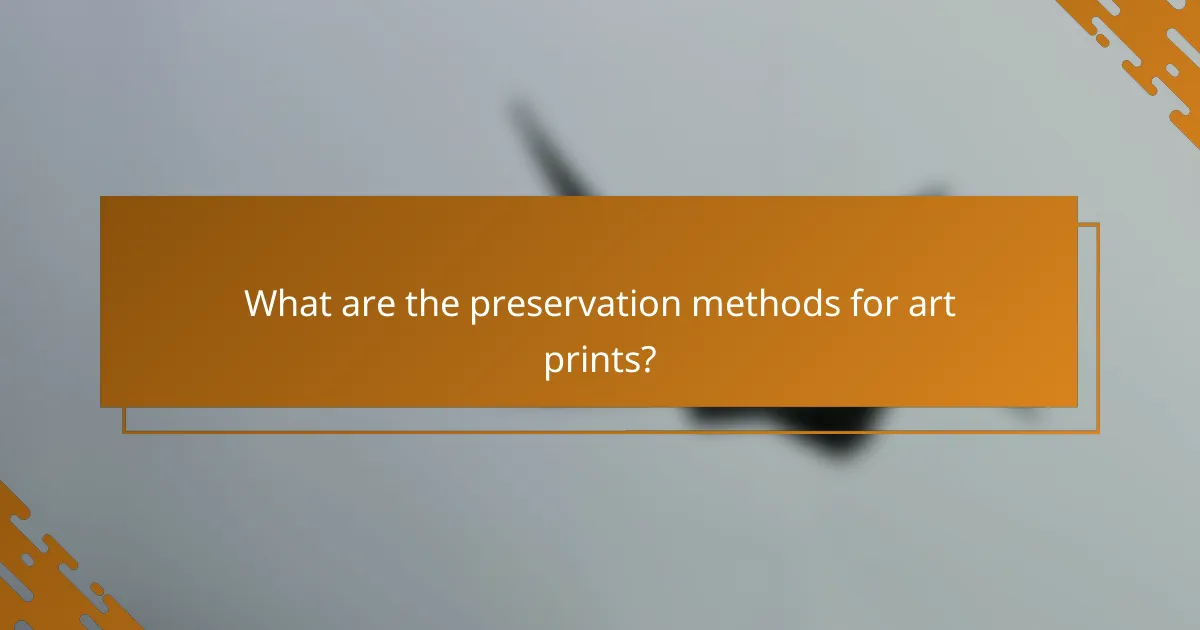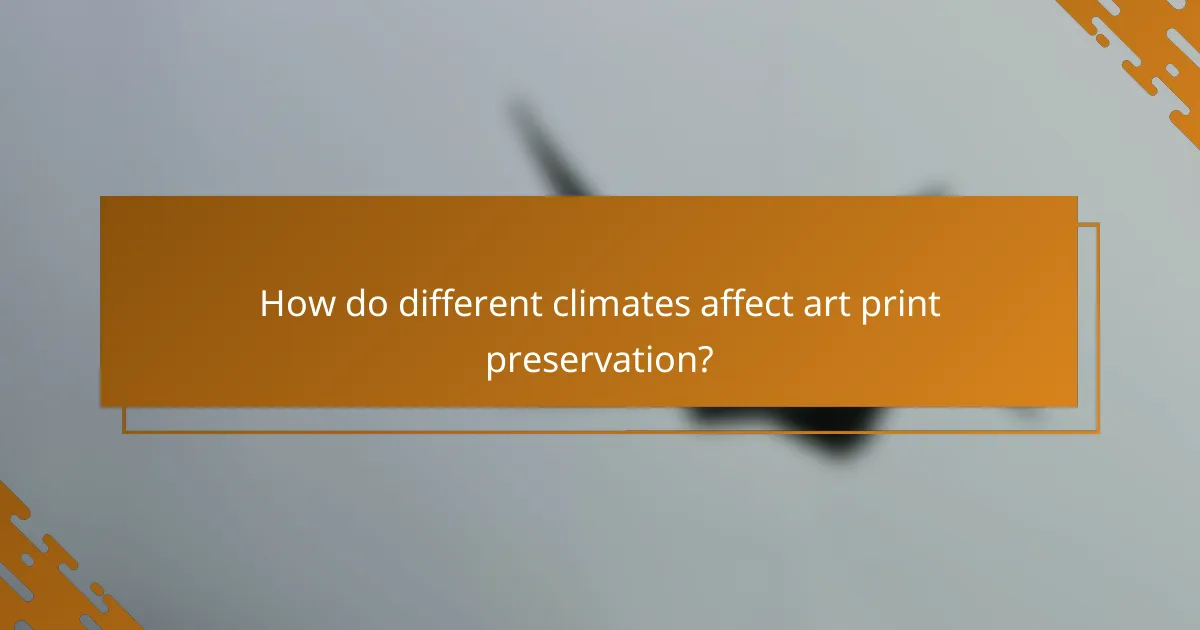Controlling humidity is crucial for the preservation of art prints, as high moisture levels can lead to mold growth and irreversible damage. To protect your artwork, it is recommended to maintain a relative humidity level between 30% and 50%. Implementing preservation methods such as archival framing, using acid-free materials, and storing prints in climate-controlled environments can significantly enhance their longevity and visual appeal.

How to control humidity for art prints?
Controlling humidity is essential for preserving art prints, as excessive moisture can lead to mold growth and damage. Maintaining a relative humidity level between 30% and 50% is generally recommended to protect your artwork.
Use dehumidifiers
Dehumidifiers are effective tools for reducing humidity levels in spaces where art prints are stored or displayed. Choose a model that suits the size of your room and can maintain the desired humidity range. Regularly check and empty the water reservoir to ensure optimal performance.
Consider using a desiccant dehumidifier for smaller spaces, as they can be quieter and more energy-efficient compared to compressor models.
Install humidity sensors
Humidity sensors help monitor the moisture levels in the environment where your art prints are kept. These devices provide real-time readings, allowing you to take action if humidity levels rise above the recommended range. Look for sensors that offer alerts or notifications for added convenience.
Place sensors in various locations to get an accurate picture of humidity fluctuations throughout the space, especially in areas prone to moisture, such as basements or near windows.
Maintain optimal temperature
Temperature and humidity are closely linked, so maintaining a stable temperature can help control humidity levels. Aim for a temperature range of 18°C to 24°C (65°F to 75°F) to create a comfortable environment for your art prints. Avoid placing prints near heat sources or in direct sunlight, as this can cause temperature spikes.
Using air conditioning or heating systems can help regulate both temperature and humidity, but ensure that these systems are well-maintained to avoid fluctuations.
Utilize silica gel packets
Silica gel packets are a simple and effective way to absorb excess moisture in small storage areas. Place these packets in frames, storage boxes, or portfolios to help maintain a stable humidity level. Replace them regularly, as they can become saturated over time.
For larger spaces, consider using silica gel canisters that can absorb more moisture and last longer between replacements.
Seal in protective frames
Using protective frames can significantly reduce humidity exposure for your art prints. Choose frames with UV-filtering glass and airtight seals to create a barrier against moisture. This not only protects the artwork from humidity but also from dust and pollutants.
Ensure that the framing materials are acid-free to prevent any chemical reactions that could damage the prints over time. Regularly inspect the seals for any signs of wear or damage to maintain their effectiveness.

What are the preservation methods for art prints?
Preservation methods for art prints involve techniques that protect the artwork from environmental damage and deterioration. Key methods include archival framing, using acid-free materials, storing in climate-controlled environments, and applying UV-protective coatings.
Archival framing techniques
Archival framing techniques are designed to protect art prints from physical damage and environmental factors. This involves using materials that do not contain harmful chemicals, such as acid-free mats and UV-filtering glass. Proper framing not only enhances the aesthetic appeal but also significantly extends the lifespan of the artwork.
When framing, ensure that the artwork is not in direct contact with the glass. Use spacers or mounts to create a gap, allowing air circulation and preventing moisture buildup. Regularly check the frame for signs of wear or damage to maintain optimal protection.
Use acid-free materials
Using acid-free materials is crucial for preserving art prints, as acidic substances can cause yellowing and deterioration over time. Look for acid-free paper, mats, and backing boards when handling or storing prints. These materials help maintain the integrity of the artwork and prevent irreversible damage.
When purchasing supplies, check for labels indicating “acid-free” or “archival quality.” This ensures that the materials will not adversely affect the print. Avoid using standard office supplies that may contain acids or lignin, which can harm the artwork.
Store in climate-controlled environments
Storing art prints in climate-controlled environments helps regulate temperature and humidity, which are critical for preservation. Ideal conditions typically involve a temperature range of 18-22°C (65-72°F) and humidity levels around 40-50%. These conditions minimize the risk of mold growth and warping.
Consider using a dehumidifier or air conditioner to maintain these levels, especially in areas with fluctuating climates. Avoid storing prints in attics or basements where conditions can be extreme. Regularly monitor the environment with a hygrometer to ensure stability.
Apply UV-protective coatings
Applying UV-protective coatings can significantly reduce the risk of fading and discoloration caused by sunlight exposure. These coatings are available as sprays or films and can be applied to the surface of the print or the glass in the frame. They act as a barrier against harmful UV rays while preserving the artwork’s colors.
When selecting a UV-protective coating, ensure it is compatible with the print medium. Test a small area first to confirm that it does not alter the appearance of the artwork. Regularly inspect the coating for wear and reapply as necessary to maintain protection.

What are the benefits of humidity control for art prints?
Humidity control is essential for preserving art prints, as it helps prevent damage caused by excessive moisture. Maintaining optimal humidity levels can enhance the longevity and appearance of prints, ensuring they remain vibrant and intact over time.
Prevents mold growth
High humidity levels can create an environment conducive to mold growth, which can severely damage art prints. By keeping humidity levels between 30% and 50%, you can significantly reduce the risk of mold, protecting your artwork from discoloration and deterioration.
Regularly monitoring humidity levels with a hygrometer can help you maintain this range. If mold does appear, it is crucial to address it immediately to prevent further damage.
Reduces fading of colors
Humidity control plays a vital role in preserving the vibrancy of colors in art prints. Excess moisture can lead to chemical reactions in inks and pigments, causing them to fade over time.
By maintaining stable humidity levels, you can help ensure that the colors in your prints remain rich and true to their original appearance. Consider using dehumidifiers or air conditioning systems to manage humidity effectively.
Extends lifespan of prints
Controlling humidity can significantly extend the lifespan of art prints. Prints exposed to fluctuating humidity are more likely to suffer from curling, warping, or cracking, which can compromise their integrity.
Investing in climate control solutions, such as specialized storage boxes or display cases with humidity control features, can help protect your prints for decades. Aim for consistent conditions to maximize their longevity.
Maintains structural integrity
Humidity affects the structural integrity of paper and canvas used in art prints. High humidity can cause materials to swell, while low humidity can lead to brittleness, both of which can result in physical damage.
To maintain the structural integrity of your prints, keep humidity levels stable and avoid placing artwork in areas prone to moisture fluctuations, such as bathrooms or basements. Proper framing and storage can also provide additional protection against humidity-related damage.

What criteria should be considered for selecting preservation materials?
When selecting preservation materials for art prints, consider factors such as material acidity levels, durability, and compatibility with the specific type of art. These criteria ensure that the chosen materials will effectively protect the artwork from deterioration over time.
Material acidity levels
Material acidity levels are crucial because acidic materials can cause irreversible damage to art prints. Look for preservation materials that are labeled as acid-free or pH-neutral, which helps prevent yellowing and degradation. A pH level of 7 or higher is generally considered safe for long-term preservation.
Common materials like certain types of paper, matting, and adhesives can vary widely in acidity. Always check product specifications to ensure they meet preservation standards.
Durability and longevity
Durability and longevity refer to how well preservation materials can withstand environmental factors over time. Choose materials that are resistant to fading, moisture, and physical wear. For instance, polyester sleeves and archival boxes are often recommended for their durability.
Consider the expected lifespan of the materials. Ideally, preservation materials should last several decades without significant deterioration, ensuring ongoing protection for your art prints.
Compatibility with art prints
Compatibility with art prints means that the preservation materials should not react negatively with the artwork. This includes avoiding materials that can cause staining or chemical reactions. For example, use cotton or linen for framing, as these materials are generally safe for various types of prints.
Additionally, ensure that any framing or mounting techniques used do not put stress on the artwork. Using proper spacers and backing can help maintain the integrity of the print while in storage or display.

How do different climates affect art print preservation?
Different climates can significantly impact the preservation of art prints. High humidity levels can lead to mold growth and paper deterioration, while excessively dry conditions can cause brittleness and cracking.
Humidity’s Role in Art Print Preservation
Humidity plays a critical role in the preservation of art prints. Ideal relative humidity levels for art prints typically range from 40% to 60%. Too much moisture can cause paper to warp and develop mold, while too little can lead to drying and cracking.
To maintain optimal humidity, consider using dehumidifiers in damp environments or humidifiers in dry areas. Regularly monitoring humidity levels with a hygrometer can help ensure your prints remain in good condition.
Temperature Considerations
Temperature also affects art print preservation. Ideally, temperatures should be kept between 18°C and 22°C (65°F to 72°F). Extreme heat can accelerate deterioration, while cold conditions can lead to brittleness.
Using climate-controlled storage solutions can help maintain stable temperatures. Avoid placing prints near heat sources or in direct sunlight, as this can cause fading and damage over time.
Light Exposure and Its Effects
Light exposure can significantly impact the longevity of art prints. Ultraviolet (UV) light, in particular, can cause colors to fade and paper to deteriorate. Limiting exposure to natural light and using UV-filtering glass for framing can help protect prints.
Consider displaying prints in low-light areas or using specialized lighting designed for art preservation. Regularly rotating displayed pieces can also minimize prolonged exposure to light.



